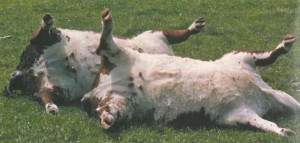Did You Know Your Cattle Need Tetanus Vaccinations?
go.ncsu.edu/readext?428332
en Español / em Português
El inglés es el idioma de control de esta página. En la medida en que haya algún conflicto entre la traducción al inglés y la traducción, el inglés prevalece.
Al hacer clic en el enlace de traducción se activa un servicio de traducción gratuito para convertir la página al español. Al igual que con cualquier traducción por Internet, la conversión no es sensible al contexto y puede que no traduzca el texto en su significado original. NC State Extension no garantiza la exactitud del texto traducido. Por favor, tenga en cuenta que algunas aplicaciones y/o servicios pueden no funcionar como se espera cuando se traducen.
Português
Inglês é o idioma de controle desta página. Na medida que haja algum conflito entre o texto original em Inglês e a tradução, o Inglês prevalece.
Ao clicar no link de tradução, um serviço gratuito de tradução será ativado para converter a página para o Português. Como em qualquer tradução pela internet, a conversão não é sensivel ao contexto e pode não ocorrer a tradução para o significado orginal. O serviço de Extensão da Carolina do Norte (NC State Extension) não garante a exatidão do texto traduzido. Por favor, observe que algumas funções ou serviços podem não funcionar como esperado após a tradução.
English
English is the controlling language of this page. To the extent there is any conflict between the English text and the translation, English controls.
Clicking on the translation link activates a free translation service to convert the page to Spanish. As with any Internet translation, the conversion is not context-sensitive and may not translate the text to its original meaning. NC State Extension does not guarantee the accuracy of the translated text. Please note that some applications and/or services may not function as expected when translated.
Collapse ▲Tetanus is caused by toxins produced by the bacterium Clostridium tetani. This bacterium is found in the soil and can survive for many years in soil and manure. Grazing animals such as sheep and cattle are at risk of tetanus, especially following wounds resulting from standard management practices such as castration, dehorning, calving, nail punctures, which can provide suitable sites for the growth of the organism. The disease is seen in animals of all ages. Affected animals typically show stiffness and muscle spasms that progress in most cases until the animal collapses, unable to stand and ultimately dies, often in a short period of time.
The disease starts when the organism enters wounded or damaged tissue as a result of contamination. In the absence of oxygen, the bacteria multiply and produce a localized infection. As they grow, the bacteria produce toxins, which spread along the nerves to the brain and cause the clinical signs of tetanus. The time between infection and disease can be very short (two or three days) or quite long (four weeks or more), depending on how long it takes for the contaminated area to develop a low level of oxygen (such as by a wound healing over sealing off the tissue from the outside). Calving and castration seem to be the most common procedures linked to the development of tetanus. Any wound can become contaminated with the bacteria; however favorable wound conditions for spore germination and toxin production occur in damaged tissue that lacks oxygen such as a poorly draining wound.
Stiffness and reluctance to move are normally the first signs. Twitching and tremors of the muscles, lockjaw, prominent protruding third eyelid and unsteady gait with stiff held out tail are signs demonstrated as the disease  progresses. Affected cattle are usually anxious and easily excited by sudden movements or handling. Bloat is common because the rumen stops working and later signs include collapse, lying on side with legs held stiffly out, spasm and death.
progresses. Affected cattle are usually anxious and easily excited by sudden movements or handling. Bloat is common because the rumen stops working and later signs include collapse, lying on side with legs held stiffly out, spasm and death.
Tetanus is easy to prevent but difficult to treat. However, if signs are detected very early and the disease is not too severe, treatment can be successful using therapeutics such as antitoxin and antibiotics. The injection of a relatively small dose of antitoxin, such as the minimum dose recommended for prevention, if given within a few hours of the injury, should provide effective protection over the usual danger period. Treatment of clinical cases can be costly and may not always be successful and unfortunately in most instances the animals are often found dead.
Tetanus can be easily prevented through the use of an effective vaccination program. Undertaking surgical procedures (such as castration) properly, in a clean environment, with disinfected instruments and surgical area, will significantly reduce the risk of tetanus. The same rules apply to calving, as a clean environment will minimize contamination. Antitoxin can be useful as a short-acting (up to 21 days) preventative if used at high risk times, however on some farms vaccination may be better.




